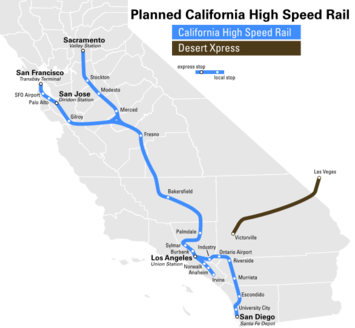
For California’s beleaguered high-speed rail project, last week brought plenty of surprises and challenges. Dominating the headlines were the resignations of several top officials of the High-Speed Rail Authority (CHSRA). Among them were board chairman Tom Umberg, CEO Roelof van Ark, board member Matthew Toledo, Deputy Director (Environment) Dan Leavitt and press secretary Rachel Wall. Dan Richard, a respected and trusted advisor of Gov. Jerry Brown, appointed to the Board last year, is expected to assume chairmanship of the Board (Umberg remains as a member of the board).
The past week also saw the release of a fresh critique of CHSRA’s business plan and an avalanche of criticism by influential commentators and analysts. The critique, entitled Twelve Misleading Statements on Finance and Economic Issue in the CHSRA’s Draft 2012 Business Plan, received wide distribution among state legislators and senior officials in Gov. Brown’s administration. It was authored by a group of independent experts who have closely followed the project over the past two years — Alain C. Enthoven, William C. Grindley, William H. Warren, Michael G. Brownrigg and Alan H. Bushell. The report challenges methodically one by one the credibility of the business plan’s key assumptions concerning the project’s construction costs and financing; revenues, ridership and operational costs; and societal benefits. (http://www.cc-hsr.org)
Last week's press commentaries added to the climate of skepticism that is increasingly engulfing the project. In close succession, there appeared a January 8 column by the well known Sacramento Bee columnist, Dan Walters (It’s Time to Kill California’s Bullet Train Boondoggle); a January 9 op-ed in The Washington Post by the newspaper’s editorial writer Charles Lane (California’s High-Speed Rail to Nowhere); and a January 10 piece in The Wall Street Journal by Wendell Cox and Joseph Vranich (California’s High-Speed Rail Fibs).
An Orange County Register editorial on January 12 further underscored the widespread opposition to the project by the state’s newspapers. The editorial sounded alarm about legislative attempts to fast-track the HSR project by exempting it from environmental review (Rep. Feuer’s Assembly Bill 1444) Waiving environmental regulations can speed project approval and undermine legal challenges, pointed the editorial. The HSR project already faces multiple court challenges on environmental grounds, with more suits likely.
Even the Sierra Club has turned critical."The draft business plan does not leave us feeling optimistic about the viability of the current high-speed rail program," wrote Kathryn Phillips, Director of Sierra Club California in a January 13 letter to the Authority. "We urge the HSRA to reconsider its business plan."
Departure of key personnel could mark a new beginning
The unexpected departure of the Authority’s top officials has added to a series of reversals experienced by the project in recent days. Most damaging has been a scathing report by the independent Peer Review Group that pronounced the Authority’s plan "not financially feasible" and warned of "immense financial risk." Adding to it has been a growing chorus of skeptical lawmakers and further news of declining public support (a SurveyUSA news poll showing only 33% of voters in favor of the bond sale).
The abrupt mass resignations of senior management are seen as a bid by Governor Brown to assert a tighter control over a project that is facing a critical first test later this spring when the legislature will be asked to vote the first $2.7 billion in bonds to start the initial 130-mile stretch of the line in the Central Valley. Last week, Brown also announced that he intends to fold the Authority into a new state transportation agency, thus placing the project under more direct supervision of the Governor.
So far, Gov. Brown has maintained steadfast support of the project, but his recent actions suggest that he is sensitive to public opinion and to the political winds blowing from the state capitol. Many lawmakers, some from the Governor’s own party, counsel against rushing ahead with construction and suggest taking the time to thoroughly rethink the business plan. They include Sen. Alan Lowenthal (D), chairman of the select committee on high-speed rail; Sen. Mark DeSaulnier (D), chairman of the transportation committee; and Sen. Joe Simitian (D), chairman of the budget subcommittee overseeing transportation. The dim prospects for any further federal funds or for private money to support the project beyond the "Initial Construction Section" must also weigh heavily in the Governor's assessment of the project's long-term viability.
In the meantime, changes may be expected in the Rail Authority’s management style. Those who know the incoming chairman well look forward to an agency that will be less confrontational, more respectful of its critics and more attentive to the legislators. They hope the Authority will be more willing to reach out and build bridges to citizen groups and will assert more control over its contractors.
Only time will tell whether last week’s events represent a true turning point for this divisive initiative. However, multiple signs coming out of Sacramento give people reasons to hope that real changes in direction are indeed underway.
Ken Orski has worked professionally in the field of transportation for over 30 years.
CA route map by Wikipedia user CountZ.












